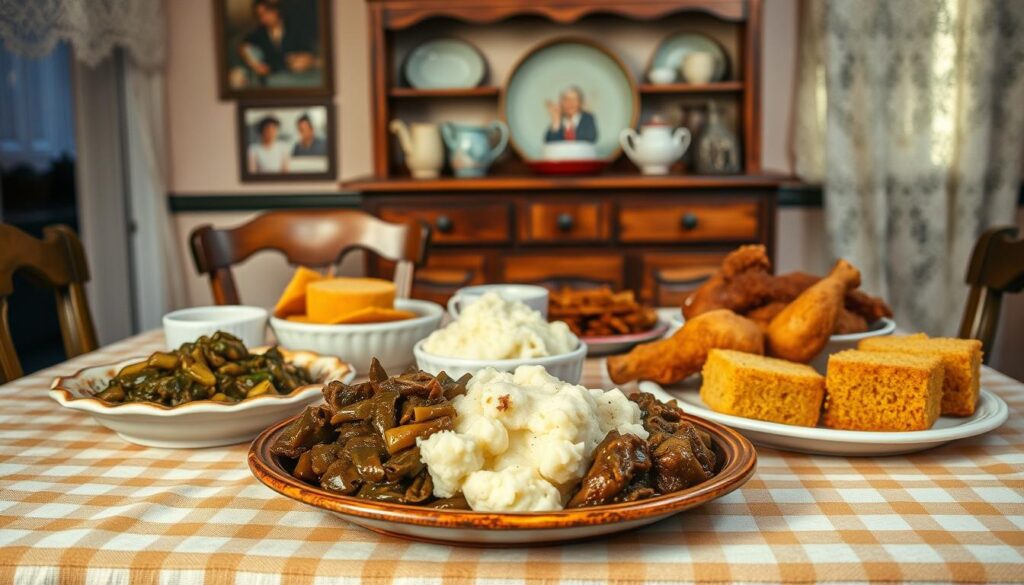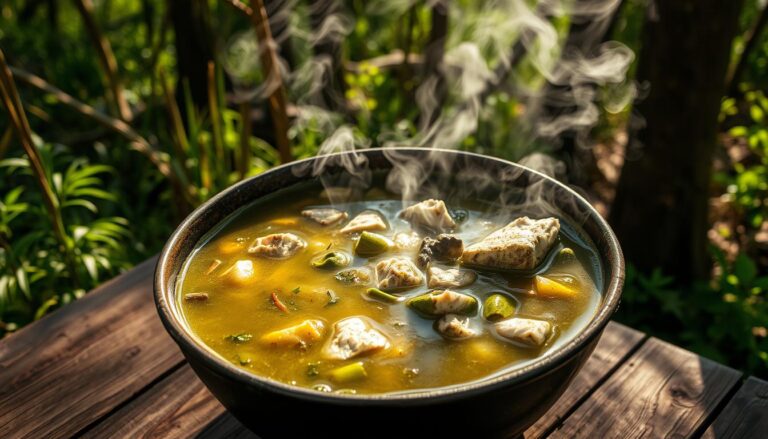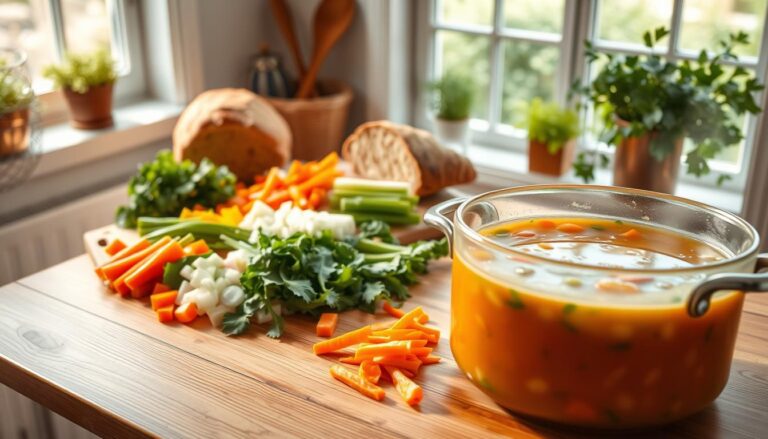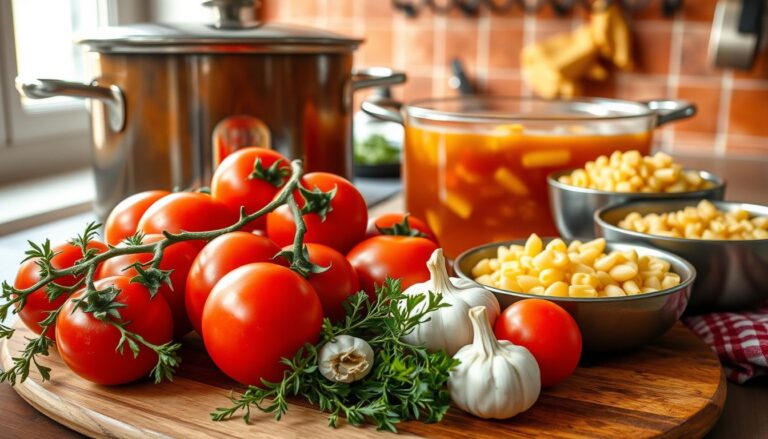Ever wondered how to create a meal that’s both comforting and packed with nutrients? This dish is the answer. With a 15-minute prep time and a total cooking duration of just over two hours, it’s a simple yet satisfying option for any day of the week.
This hearty southern-style creation combines fresh greens with savory meats like kielbasa, creating a flavor that’s rich and deeply rooted in tradition. Whether you’re a seasoned cook or just starting out, the process is straightforward and rewarding.
Not only is this meal delicious, but it’s also a powerhouse of nutrients. Packed with vitamins A, C, and K, it supports your immune system, skin health, and bone strength. Plus, it’s low in calories, making it a great choice for those mindful of their diet.
Ready to dive in? Discover how to prepare this wholesome dish using both stovetop and slow cooker methods. It’s time to bring a taste of the South to your table!
Table of Contents
Introduction to Turnip Green Soup
Discover the charm of a Southern classic with turnip green soup. This dish is a timeless favorite, loved for its simplicity and rich, layered flavors. Whether you’re a beginner or an experienced cook, it’s easy to prepare and always satisfying.
Fresh turnip greens are the star of this soup, adding both taste and nutrition. Packed with vitamins and minerals, they make this meal as healthy as it is delicious. The greens are combined with savory ingredients like sausage or ham, creating a hearty and comforting dish.
Rooted in Southern culinary traditions, this soup is more than just a meal—it’s a piece of history. It’s a dish that brings families together, offering warmth and nourishment. The recipe is adaptable, making it perfect for any occasion or skill level.
What makes this soup truly special is its balance of flavor and health. The turnip and other quality ingredients work together to create a wholesome, satisfying experience. Ready to explore its origins and techniques? Let’s dive into the story behind this beloved dish.
Origin and History of Turnip Green Soup
Have you ever tasted a dish that tells a story of history and tradition? This hearty meal has deep roots in Southern culture, where it has been a staple for generations. Its origins reflect the resourcefulness of Southern cooks, who turned simple ingredients into nourishing meals.
In the early 1800s, Southern households relied on what they could grow or raise. Turnip greens were a common crop, valued for their hardiness and nutritional benefits. Paired with leftover ham bones, they became the foundation of this beloved dish. This combination not only maximized resources but also created a rich, savory flavor.
Over the years, the dish evolved from a practical home remedy to a comfort meal enjoyed by families across the South. It became a symbol of resilience and tradition, often served during gatherings and holidays. The use of ham bones, in particular, highlights the ingenuity of Southern cooking, where nothing went to waste.
Southern Roots and Traditions
This dish is deeply tied to Southern agricultural practices. Farmers grew turnip greens as a reliable source of food, especially during the colder months. The greens were often cooked with smoked meats, like ham or sausage, to add depth and richness to the meal.
Passed down through generations, the recipe reflects the blending of resourcefulness and tradition. Families would gather around the table to share this hearty soup, making it a cherished part of Southern heritage. Its simplicity and flavor have kept it relevant even in modern kitchens.
Cultural Significance Today
Today, this dish remains a symbol of Southern hospitality and comfort. It’s often featured at community events, family reunions, and holiday meals. Its preparation continues to honor the traditions of the past while adapting to contemporary tastes.
Historical influences, like the use of ham bones, still inspire modern recipes. This connection to the past makes the dish more than just a meal—it’s a celebration of culture and history. Whether enjoyed at home or in a restaurant, it brings a taste of the South to every table.
| Historical Period | Key Development |
|---|---|
| Early 1800s | Introduction of turnip greens and ham bones as staple ingredients |
| Late 1800s | Recipe becomes a household favorite in Southern communities |
| Modern Era | Adaptation to contemporary tastes while preserving traditional methods |
Essential Ingredients for a Flavor-Packed Soup
What makes a truly unforgettable soup? It’s all about the ingredients. Each component plays a vital role in creating a dish that’s rich in flavor and packed with nutrients. Let’s explore the key elements that make this dish a standout.
Fresh Turnip Greens and Their Nutrients
At the heart of this dish are fresh turnip greens. These leafy vegetables are not only flavorful but also a powerhouse of vitamins A, C, and K. They add a slightly bitter, earthy taste that balances the richness of the other ingredients.
Using high-quality turnip greens ensures the soup has a fresh, vibrant flavor. If you can’t find them, kale or collard greens make excellent substitutes. The key is to choose greens that are firm and deep green in color for the best results.
Importance of Sausage, Ham Bone, and Beans
Savory meats like sausage and ham bone bring depth and heartiness to the soup. The ham bone, in particular, infuses the broth with a smoky, rich flavor that’s hard to replicate. Sausage adds a spicy kick, making each bite more exciting.
Beans, such as Great Northern or cannellini, provide a creamy texture and a boost of protein. They also absorb the flavors of the broth, making them a perfect complement to the greens and meats. Together, these ingredients create a harmonious blend of taste and nutrition.
When selecting your ingredients, always opt for freshness and quality. Whether it’s the turnip greens, the sausage, or the beans, each element contributes to the overall authenticity and flavor of the dish. With the right components, you’ll create a soup that’s both comforting and unforgettable.
Recipe for Turnip Green Soup
Ready to master a classic Southern dish that’s both hearty and nutritious? This guide will walk you through the process, ensuring every step is clear and easy to follow. Whether you prefer the stovetop or a slow cooker, you’ll achieve a flavorful result every time.

Step-by-Step Cooking Process
Start by browning the sausage in a large pot over medium heat. This step takes about 5–7 minutes and adds a rich, savory base to the dish. Next, sauté the onions and garlic until they’re soft and fragrant, which usually takes another 3–4 minutes.
Add the turnip greens, beans, and broth to the pot. Bring the mixture to a boil, then reduce the heat to a simmer. Let it cook for about 2 hours, stirring occasionally to blend the flavors. The long cook time allows the ingredients to meld together, creating a deeply satisfying dish.
Season with garlic powder, Creole seasoning, and a touch of hot pepper sauce. Adjust the spices to your taste, ensuring the final product is perfectly balanced. Serve hot and enjoy the comforting flavors of this Southern classic.
Slow Cooker vs. Stovetop Methods
If you’re using a slow cooker, begin by browning the sausage and onions on the stovetop. Transfer them to the slow cooker, along with the turnip greens, beans, and broth. Set it to low heat and let it cook for 6–8 hours. This method is ideal for busy days, as it requires minimal supervision.
The stovetop method, on the other hand, offers more control over the cooking process. You can adjust the heat and stir the mixture as needed, ensuring the flavors develop evenly. Both methods yield delicious results, so choose the one that best fits your schedule.
Whichever method you choose, the key is to follow the steps carefully. Properly browning the meat, simmering the ingredients, and seasoning to taste will reward you with a dish that’s both comforting and full of flavor.
Preparing the Turnip Greens for Maximum Flavor
Want to unlock the full potential of your dish? Start with the greens. Properly preparing turnip greens ensures they’re clean, flavorful, and ready to enhance your meal. Here’s how to handle them like a pro.
First, rinse the greens thoroughly. Fresh-picked turnip greens often have dirt or grit, so soak them in cold water for a few minutes. Swish them around to loosen any debris, then drain and repeat until the water runs clear. Pre-rinsed greens still benefit from a quick rinse to ensure cleanliness.
Next, trim the stems. While some stems are tender and edible, thicker ones can be tough. Remove them by folding the leaf in half and slicing along the stem. This step ensures a more enjoyable texture in your dish.
Cut the greens into bite-sized pieces. Tearing or chopping them helps release their natural flavors during cooking. Handle them gently to maintain their texture and avoid bruising.
To reduce bitterness, blanch the greens briefly in boiling water for 1-2 minutes, then plunge them into ice water. This method softens their flavor while preserving nutrients. Alternatively, cooking them slowly with savory ingredients like sausage or ham can balance their taste naturally.
Store prepared greens in an airtight container in the fridge for up to three days. If you’re using them immediately, pat them dry to avoid diluting the soup’s flavor. Proper preparation is key to an intensely flavorful dish.
Experiment with these techniques to find what works best for you. Whether you’re using fresh-picked or pre-rinsed greens, taking the time to prepare them properly will elevate your meal to the next level.
Selecting the Perfect Sausage and Ham Bone
Choosing the right sausage and ham bone can transform your dish into a flavor-packed masterpiece. These ingredients are the backbone of a rich, hearty meal, so selecting them carefully is essential.

When it comes to sausage, the options are vast. Kielbasa, a Polish smoked sausage, offers a mild, smoky flavor that blends well with other ingredients. Cajun Conecha, on the other hand, brings a spicy kick, perfect for those who enjoy a bit of heat. The choice depends on your taste preferences and the flavor profile you want to achieve.
A ham bone adds depth and richness to the broth. Look for one with some meat still attached, as it infuses the dish with a savory, smoky taste. If ham bones are hard to find, smoked ham hocks are a great alternative. They provide a similar flavor but with a slightly fattier texture.
Comparing Kielbasa and Cajun Conecha Sausage
Kielbasa is known for its smooth texture and subtle smokiness, making it a versatile choice. Cajun Conecha, with its bold spices, adds a vibrant, Southern-inspired twist. Both types of sausage enhance the dish, but their unique characteristics will influence the final taste.
When sourcing these ingredients, consider visiting local markets or butchers. Fresh, high-quality meats make a noticeable difference in flavor. Traditional Southern recipes often emphasize the importance of using the best available ingredients, and this dish is no exception.
Balancing the meat with the vegetable components is key. The sausage and ham bone should complement, not overpower, the greens and beans. This harmony creates a robust yet well-rounded meal that’s both satisfying and deeply flavorful.
Sautéing Onions and Garlic to Build a Rich Base
The foundation of any great dish lies in its base, and sautéing onions and garlic is where it all begins. This step is crucial for developing depth and complexity in your meal. When done correctly, it creates a flavorful foundation that enhances every bite.
Techniques for Perfect Browning
Start by heating oil in a pan over medium heat. Use about 1-2 tablespoons of vegetable or olive oil, ensuring the pan is evenly coated. Add diced onions and stir occasionally to prevent burning. The goal is to achieve a soft, golden texture, which usually takes 5-7 minutes.
Once the onions are translucent, add minced garlic. Cook for an additional minute, stirring constantly to avoid scorching. The aroma at this stage is a sign that the flavors are developing perfectly. This process not only enhances the natural sweetness of the vegetables but also sets the stage for a rich, savory base.
Here are some troubleshooting tips to ensure success:
| Issue | Solution |
|---|---|
| Browning too fast | Reduce heat slightly and stir more frequently. |
| Browning too slow | Increase heat slightly and ensure the pan isn’t overcrowded. |
| Uneven browning | Stir more consistently and ensure even oil distribution. |
Attention to detail during this step is key. The careful balance of heat, timing, and stirring ensures that your base is flavorful and aromatic. As the saying goes,
“Good cooking starts with a good foundation.”
By mastering this technique, you’ll elevate your dish to new heights, creating a meal that’s both comforting and deeply satisfying.
Choosing the Right Broth and Soup Mix
The secret to a flavorful dish often lies in the broth and mix you choose. A rich, clear base can elevate your meal, while the right soup mix binds all the flavors together seamlessly. Whether you’re using homemade or store-bought options, quality matters.
Start with the broth. Low-sodium chicken broth is a popular choice, offering a savory base without overwhelming saltiness. It’s versatile and pairs well with other ingredients. If you prefer a richer taste, consider homemade broth, which allows you to control the seasoning and depth of flavor.
Next, think about the soup mix. A product like Knorr’s® vegetable soup mix can simplify the cooking process while adding layers of flavor. It’s a convenient option that complements the broth and enhances the overall taste. If you don’t have a mix on hand, you can boost flavor with extra herbs, spices, or a splash of Worcestershire sauce.
Here’s why the combination works: the broth provides the liquid foundation, while the mix adds complexity. Together, they create a harmonious blend that enhances every bite. Experiment with different brands to find your favorite, and remember, the clearer and richer the broth, the more balanced your dish will be.
“The right broth and mix can transform a simple dish into something extraordinary.”
Whether you’re cooking for a crowd or just for yourself, understanding these choices is essential. The right combination not only streamlines the process but also ensures a meal that’s both comforting and deeply satisfying.
Enhancing the Soup with Beans and Legumes
Looking to add more heartiness and nutrition to your meal? Beans and legumes are the perfect ingredients to elevate your dish. They bring a rich texture, protein, and essential nutrients that make every bite more satisfying.
Beans like Great Northern are a standout choice. They have a creamy texture that blends seamlessly with other ingredients. Plus, they’re packed with protein and fiber, making your meal both filling and nutritious.
Benefits of Great Northern Beans
Great Northern beans are versatile and mild in flavor, making them a great addition to any dish. They absorb the flavors of the broth and other ingredients, enhancing the overall taste. Their soft texture also helps thicken the soup naturally.
Legumes, in general, are a powerhouse of nutrients. They provide dietary fiber, which supports digestion, and essential vitamins like iron and folate. Adding them to your meal boosts its health benefits without compromising on flavor.
When using canned beans, rinse and drain them thoroughly. This removes excess sodium and ensures a cleaner taste. If you’re experimenting, try black-eyed peas or kidney beans for a different twist. Each type brings its unique flavor and texture to the dish.
Pairing beans with ingredients like sausage or ham creates a balanced meal. The combination of protein, fiber, and savory flavors makes the dish more satisfying. It’s a simple way to add depth and nutrition to your cooking.
“Beans and legumes are not just fillers—they’re flavor enhancers and nutritional powerhouses.”
Whether you’re using Great Northern beans or exploring other legumes, these additions make your meal more wholesome. They’re an easy way to boost both the taste and health benefits of your dish.
Perfecting the Seasoning and Heat Balance
Finding the right balance of spice and seasoning can make or break your dish. It’s the secret to creating a meal that’s bold, flavorful, and perfectly satisfying. Whether you’re aiming for a subtle kick or a fiery punch, mastering this balance is essential.

Start with the basics: pepper sauce and Creole spices. A dash of Tabasco® hot pepper sauce adds a tangy, fiery note, while Tony Chachere’s® Creole seasoning brings depth and complexity. These ingredients work together to enhance the natural flavors of your dish.
Using Pepper Sauce and Creole Spices
When adding pepper sauce, start small. A few drops can go a long way in elevating the heat. Stir it in gradually and taste as you go. This ensures you achieve the desired level of spiciness without overwhelming the dish.
Creole spices, on the other hand, are all about balance. They combine garlic, onion, and a blend of herbs to create a rich, savory flavor. Sprinkle them in during the cooking process to allow the spices to meld with the other ingredients.
Here’s a pro tip: always add salt gradually. Too much too soon can overpower the dish. Start with a pinch, taste, and adjust as needed. This method ensures every bite is perfectly seasoned.
“Seasoning is not just about adding flavor—it’s about creating harmony in every bite.”
To maintain balance, stir consistently. This ensures the spices and heat are evenly distributed. Taste-testing throughout the process is key. It allows you to make adjustments and achieve the perfect flavor profile.
If you prefer a milder dish, reduce the amount of pepper sauce or opt for a milder Creole blend. For those who love a bold kick, feel free to add more. The beauty of seasoning lies in its flexibility—it’s all about personal preference.
Remember, precision is key. A well-seasoned dish is a testament to careful preparation and attention to detail. With the right balance of pepper, heat, and salt, you’ll create a meal that’s both comforting and unforgettable.
Managing Cooking Time and Temperature
Mastering the art of simmering is the key to unlocking deep, rich flavors in your dish. Properly managing time and temperature ensures that every ingredient melds together perfectly, creating a harmonious and satisfying meal.
Simmering Tips for Depth of Flavor
Simmering is a gentle cooking method that allows flavors to develop gradually. Unlike a rolling boil, which can break down ingredients too quickly, a low-temperature simmer preserves texture while enhancing taste. This method is ideal for dishes that require patience and precision.
To maintain an even temperature, keep the heat low and stir occasionally. This prevents scorching and ensures that the flavors blend seamlessly. Extended simmering, often lasting two hours or more, deepens the taste of meats and vegetables, creating a more complex and satisfying dish.
- Use a heavy-bottomed pot to distribute heat evenly.
- Adjust the heat as needed to maintain a gentle bubble.
- Set a timer to check the dish periodically, ensuring it doesn’t overcook.
For those using a slow cooker, the process is even simpler. Set it to low heat and let the ingredients cook for 6-8 hours. This method requires minimal supervision and results in a deeply flavorful dish. Whether you’re using a stovetop or slow cooker, patience is essential. Trust the process, and you’ll be rewarded with a meal that’s rich, hearty, and unforgettable.
“Good things come to those who wait—especially when it comes to simmering.”
Balancing the heat is crucial. Too high, and you risk burning the dish; too low, and the flavors won’t develop fully. By mastering this technique, you’ll create a dish that’s both comforting and deeply satisfying.
Crafting a Southern-Style Comfort Meal
Bring the warmth of Southern tradition to your table with a meal that’s as comforting as it is flavorful. Serving this dish is more than just plating food—it’s about creating an experience that feels like home. Start by ladling the turnip green soup into deep bowls, ensuring each serving is brimming with hearty greens and savory broth.
Pair it with a slice of buttery, homemade cornbread for the ultimate Southern touch. The slightly sweet, crumbly texture of the bread complements the rich, earthy flavors of the green soup, making every bite a perfect balance. This combination is a classic for a reason—it’s simple, satisfying, and deeply rooted in tradition.

Garnish the dish with fresh herbs or a dash of pepper sauce for an extra layer of flavor. These small touches elevate the presentation and add a pop of color. Serve it family-style, placing the pot of soup and a basket of cornbread in the center of the table. This encourages sharing and creates a sense of togetherness, perfect for gatherings.
Every spoonful of this meal offers a taste of heritage and warmth. It’s not just food—it’s a connection to the past, a celebration of Southern culture. The rich, layered flavors transform into a comforting dinner that’s both nourishing and nostalgic.
“A meal steeped in tradition is more than sustenance—it’s a reminder of where we come from.”
Here are a few tips to enhance your presentation:
- Use rustic bowls or mason jars for a down-home feel.
- Add a sprig of parsley or thyme for a fresh, aromatic touch.
- Serve with a side of pickled vegetables for a tangy contrast.
This dish is more than just a meal—it’s a testament to the pride and resilience of Southern cooking. Whether enjoyed alone or with loved ones, it’s a comforting reminder of the simple joys in life.
Nutritional Benefits and Caloric Information
Understanding the nutritional value of your meals can help you make healthier choices. This dish is not only delicious but also packed with essential nutrients that support overall health. Let’s break down the key nutritional highlights.
One serving contains 228 calories, making it a relatively low-calorie option for a hearty meal. The macronutrient breakdown includes 8g of fat, 25g of carbohydrates, and 15g of protein. This balance ensures you stay full and energized without overloading on calories.
The star ingredient, turnip, is rich in vitamins A, C, and K. These nutrients support immune function, skin health, and bone strength. Combined with other vegetables, this dish provides a significant dose of antioxidants and anti-inflammatory compounds.
Here’s how this meal contributes to a balanced diet:
- Provides essential vitamins and minerals.
- Offers a good source of dietary fiber for digestion.
- Includes lean protein for muscle repair and growth.
Despite its hearty nature, this dish remains low in calories, making it a great choice for those watching their intake. The blend of protein, fiber, and vitamins supports overall health and wellness.
“A nutritious meal doesn’t have to sacrifice flavor—this dish proves it.”
Incorporating this meal into your routine can help you meet daily vegetable intake recommendations. It’s a simple way to enjoy a comforting, nutrient-packed dish that fits into a healthy lifestyle.
Variations and Substitutions for a Custom Twist
Customizing your meal can make it uniquely yours while keeping it delicious and nutritious. This dish is highly adaptable, allowing you to tailor it to your preferences or dietary needs. Whether you’re vegetarian, looking for alternative proteins, or simply want to experiment, there are plenty of ways to put your own spin on it.
Vegetarian and Alternative Protein Options
For a vegetarian version, replace the sausage or ham bone with plant-based proteins like tofu, tempeh, or seitan. These options provide a similar texture and absorb the flavors of the broth beautifully. You can also add extra beans or lentils for a protein boost.
If you’re not vegetarian but want to try something different, consider using turkey sausage or smoked turkey legs instead of traditional pork. These alternatives maintain the smoky, savory flavor while offering a leaner option.
Creative Ingredient Swaps
Experiment with spices to create a unique flavor profile. Add a pinch of smoked paprika or a dash of cumin for a warm, earthy taste. For a tangy twist, try a splash of apple cider vinegar or lemon juice.
Altering ingredient quantities can also change the soup’s consistency. Add more broth for a lighter dish or reduce it for a thicker, stew-like texture. You can even incorporate additional vegetables like carrots, celery, or sweet potatoes for extra depth.
“The beauty of cooking lies in its flexibility—don’t be afraid to make it your own.”
These variations still honor the original southern-style essence while making the meal more accessible to different dietary needs. Whether you’re swapping ingredients or adjusting quantities, the core principles of the recipe remain intact. This flexibility ensures that every bowl is as unique as the person preparing it.
Conclusion
There’s something deeply satisfying about a dish that blends tradition with nourishment. From its rich Southern roots to its simple preparation, this meal is a testament to the power of good food. By mastering techniques like sautéing, simmering, and seasoning, you can create a dish that’s both comforting and flavorful.
This green soup is more than just a meal—it’s a celebration of culture and community. Its nutritional benefits, including vitamins and lean protein, make it a wholesome choice for any table. Whether you follow the classic method or experiment with variations, the result is always hearty and satisfying.
Invite your loved ones to share in this experience. Good food has a way of bringing people together, creating memories that last. So, why not try making this dish today? Every spoonful is a taste of tradition and innovation, a reminder that the best meals are made with care and creativity.
FAQ
What makes turnip green soup a Southern classic?
This dish is deeply rooted in Southern traditions, often featuring hearty ingredients like sausage, ham bone, and beans. It’s a staple for comfort food lovers.
Can I use a slow cooker for this soup?
Yes, a slow cooker works well. It allows the flavors to meld together over several hours, creating a rich and satisfying meal.
What’s the best way to prepare turnip greens?
Wash them thoroughly to remove grit, then chop them into bite-sized pieces. Cooking them with onions and garlic enhances their natural flavor.
What type of sausage should I use?
Kielbasa or Cajun Conecha sausage are excellent choices. They add a smoky, spicy kick that complements the greens and beans.
How do I balance the heat in the soup?
Adjust the amount of pepper sauce or Creole spices to your preference. Start with a small amount and add more as needed.
Can I make this soup vegetarian?
Absolutely. Skip the sausage and ham bone, and use vegetable broth. Add extra beans or tofu for protein.
What’s the ideal cooking time for this dish?
Simmer the soup for at least 45 minutes to an hour. This allows the flavors to develop fully and the greens to soften.
Are there any nutritional benefits to this soup?
Yes, it’s packed with vitamins from the greens, protein from the sausage and beans, and fiber for a balanced, hearty meal.
Can I freeze leftovers?
Definitely. Store it in an airtight container and freeze for up to three months. Reheat on the stovetop for best results.
What’s the best side to serve with this soup?
Cornbread is a classic pairing. Its slightly sweet flavor complements the savory notes of the dish perfectly.







